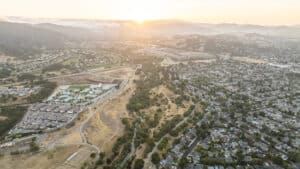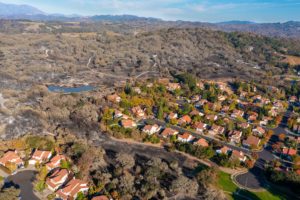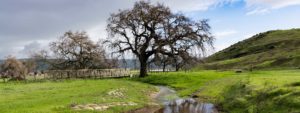A complete street is one that follows the 8-80 rule—whether you are 8 or 80 years old, the road is safe for you to use. The intersection of West San Carlos Street and South Bascom Avenue in San Jose is far from safe.
Imagine being blind and crossing the intersection of West San Carlos Street and South Bascom Avenue, pictured above. People do it often, as the Santa Clara Valley Blind Center is just two blocks away. Imagine encountering this intersection with a child or a pet in tow. Would you feel safe getting across?
The harsh reality of incomplete streets came to light when Greenbelt Alliance Regional Director Michele Beasley had the opportunity to audit this neighborhood’s streets with a team of San Jose State University urban planning graduate students. On a block by block basis, the team noted details about each street such as the number and location of garbage cans, bike racks, and trees. West San Carlos and South Bascom are designed for cars, but there is a significant number of people using these streets without a car.
A need for Complete Streets
During their audit, the team observed people who were forced to jaywalk and ride their bike on the sidewalk. But who could blame them? Crosswalks and bike lanes are few and far between in this neighborhood. Groups of children leaving school and mothers pushing strollers squeezed by each other along sidewalks often no more than 5 feet wide. And despite being a busy bus route, those waiting for the bus often did not have a bench or shelter to use while they waited.
Clearly, West San Carlos Street and South Bascom Avenue are far from “complete.”
Streets should be designed for everyone: motorists and cyclists, walkers and wheelchair users, bus riders and shopkeepers. San Jose residents and planners will need to keep this in mind as the City kicks off urban village planning and VTA begins outreach for Bus Rapid Transit.
The Report
The San Jose State students’ audit and SWOT analysis (Strengths/Weaknesses/Opportunities/Threats) were compiled into a findings report: the Complete Streets Audit and Community Engagement report. In an easy-to-read document, the graduate team outlines their findings, methodology, and engagement with the community, while also providing a brief historical account for this cluster of neighborhoods.
In the report, you’ll find an assessment of the community’s top priorities (pg. 12), a chart summarizing the percentage of street segments that have trees and public art (pg. 30), and a snapshot of the long-gone Burbank Velodrome (pg. 19).
Greenbelt Alliance will encourage San Jose residents to use the findings from this report to advocate for the amenities they want to see in their neighborhood. Together, we can bring real, positive, on-the-ground change to the community.



